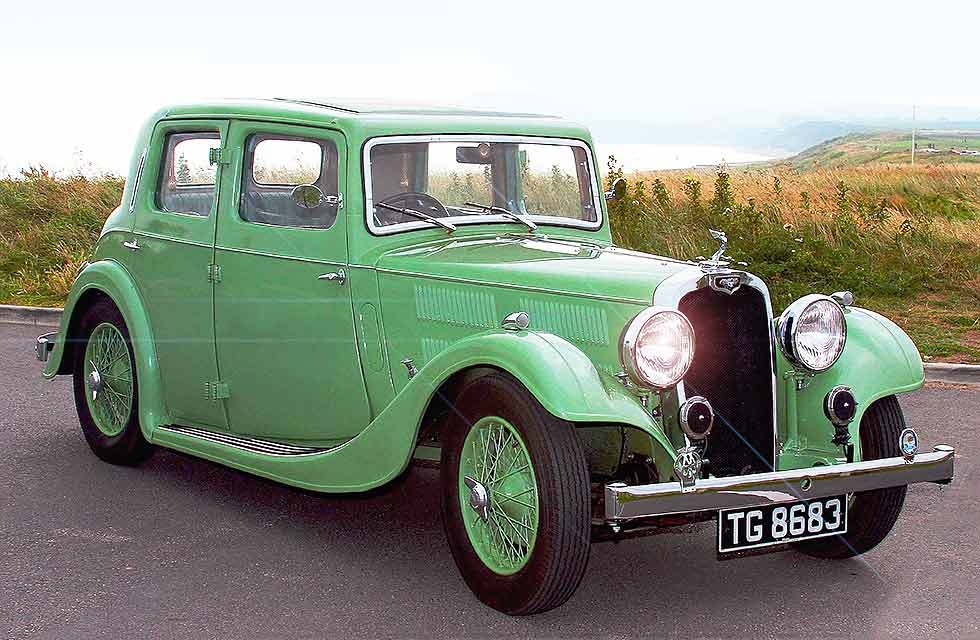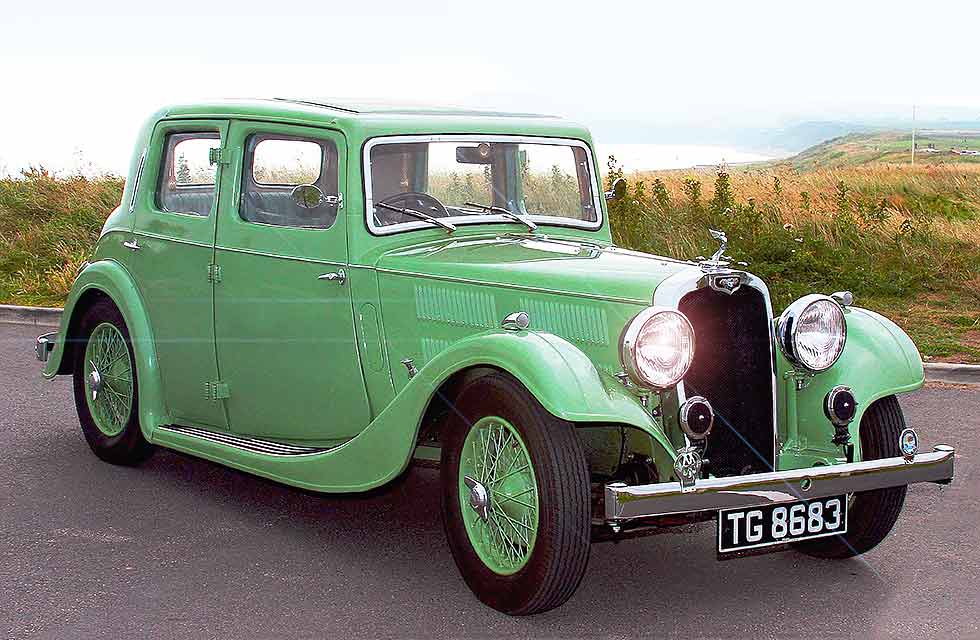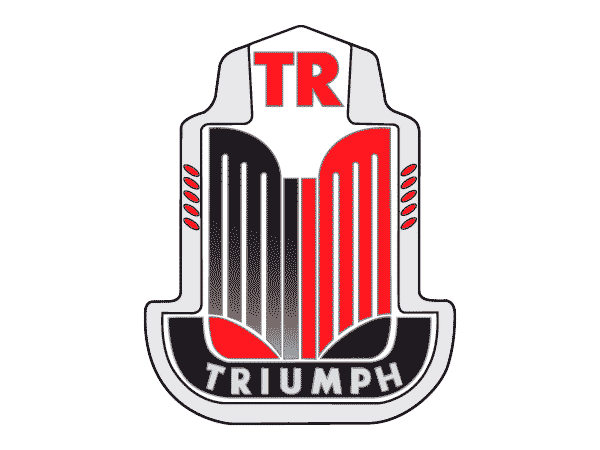
1934 Triumph Gloria Pre-war motoring is a whole new experience for this serial Triumph owner. David and Chris Ferguson have a long history with Triumphs, but until recently it was only the post-war variety that had graced their drive. Then Chris saw a pre-war Gloria and, to borrow a phrase from Little Britain, she said: ‘I want that one!’ Story and pictures: Simon Goldsworthy.
I want that one…
David has been a Triumph enthusiast ever since he was 17 years old. First he got a motorbike, then a Spitfire, and he’s since had a Triumph of one kind or another virtually all his life. In fact he did work it out once and calculated that he’d only been without a Triumph for a total of 18 months all told.

Chris is pretty keen on her Triumphs too, and David is largely to blame for that. When they first started dating, he took her to a Triumph show where Chris fell in love with a Vitesse convertible. She loved the colour scheme on that car of white paint and black interior, but mostly it was the fins at the back and the overall shape that got her hooked – not being into cars until then, she had never seen anything quite like it.
Talking of being hooked, there were a couple of pointers that David and Chris were pretty hooked on each other too. Well, three if you count the fact that they got married, but to our minds more telling is the fact that David sold the TR3 he was running at the time to raise a deposit on a house, and together they scoured the country to find a white Vitesse with a black interior, just like the one Chris had seen at the show.
When they took their new purchase to show David’s mother, she told Chris: ‘It’s very nice, but you won’t have it long – he always sells his cars and buys another one pretty quickly!’ Chris remembers thinking: ‘He won’t sell this one because it is mine!’ And she was right – the couple still own that very car. It has since become a family joke that the classic cars all belong to Chris, which is why David has had to keep them.
In his defence, David does say: ‘I didn’t sell them to make money, I just used to chop and change cars to find out what I liked. The only way of really getting to know a car is to own one and see how you get on with it. I got through pretty much the whole post-war Triumph range in this way. Going in order there was a Spitfire, TR4A, 2000 estate, TR3, TR6, TR3A, 2.5PI, MkI Vitesse 1600, 1200 Herald saloon, 2500S estate… Oh yes, and before we were married Chris and I did buy another car together, one which we still have. That’s a Triumph Italia, which we got as an abandoned project. We have kept it through a number of house moves and I have started some of the restoration, but it has been on the back burner for some time now. I retire next year in March, so the plan is that I will then crack on with the Italia.’
As well as the Italia and the Gloria in our pictures (which we will get to shortly), the couple have two other Triumphs as well. Alongside the white Vitesse convertible we introduced earlier, they also have a 2000 estate. ‘I’d always liked the big estates,’ says Chris, ‘and one day in 2010 we were at a show looking at a yellow one when the friend who was with us said: “I know where there might be one of those for sale…”’
It turned out that it had been sitting in his brother-in-law’s garage for over 20 years. The car had been given new sills before it was laid up, but the wheelarches were now a bit frilly and the brakes nonexistent. David discovered that latter point when they rolled it out of the garage and it just kept rolling down the drive at a great rate of knots. Fortunately they did manage to stop it before anything drastic happened. ‘And don’t forget the Fergie,’ adds David. ‘I like anything with wheels, and that came to us as a garden ornament.’
‘Of course, David then had to restore it,’ adds Chris. ‘He used to do road runs for local shows, but I was being left at home, so then we got a two-seater David Brown Cropmaster too! We have just sold that, but the Fergie is back to being a garden ornament, albeit a driveable one – on a Sunday morning David sometimes hops on it to visit a friend three miles away for a coffee.’
And so at last to the Gloria. That is another car for which Chris takes the blame – or the credit, depending on your point of view. ‘We’d seen one at the Triumph 2000 National,’ she explains. ‘It just didn’t look like any Triumph I knew. I am visually impaired, so we asked the owner if I could feel his car. As you might expect, he looked a bit bemused, but said yes. I do have some sight left (and had more back then as it was three years ago) so I knew the general outline, but running my hands over the car showed me the curves and the details.’
Chris was really taken with the car, and of course she only had to say that to David and he was off and hunting. So Chris got a model of a Gloria for her birthday in November 2015, and the real thing in December of that year. The car they had seen was a six cylinder Gloria Vitesse and David would really have liked one of those, but none were available at the time so he got close with a four cylinder Gloria 10.8HP.
Built in 1934, it was a pretty advanced piece of kit at the time. The engine was a 1232cc Coventry Climax inlet-over-exhaust unit, there was a four speed gearbox and hydraulic brakes too. It was still something of a learning curve for David though, as the furthest back in motoring history he’d been up to this point was a TR2.
The Gloria had been restored in the 1990s, but although it was still driveable and roadworthy in 2016, it was starting to get very shabby – the wings were blistering, and the body was sound but very scruffy. ‘We drove it for a year as it was,’ recalls David, ‘but it had one or two other issues besides the scruffiness – the shock absorbers weren’t working properly and the rear springs had sagged terribly for example, so I had those reconditioned.
‘Then I decided that I just couldn’t live with the body looking so bad. I thought it would take me around three months to sort out, but it ended up taking all of 2017. Like all restoration jobs, you take one piece off and think: “I can’t stop here…” So another bit comes off, then another. In the end I had all the opening panels off, except for the sliding roof – that was working fine and I didn’t want to mess around with it in case I opened a whole new can of worms.’
David does his own blasting, and the rear wings virtually disappeared under this onslaught – the 1990s restoration had included rather a lot of fibreglass matting and careful sculpting. They managed to get a pair of secondhand wings from Rob Green and did minor repairs to those, but the front wings were totally unobtainable. Unfortunately they are big panels that flow into running boards which go all the way to the back, and on this car the running board section was virtually nonexistent. That’s the main reason why it took so much longer to sort out than David had planned, because fabricating the necessary panels seemed to take forever.
Looking through the paperwork that came with the car, David was able to piece together a little of its restoration history. ‘The engine was rebuilt in 1991,’ he says. ‘It is a little smokey now and the valve guides need doing, but it is OK. The body came off in 1994, and the interior was done in 2003 which saved me a bit of money. If I was doing it again I might have picked a different shade of green, but it goes with the car well enough.’
Working on this era of car was certainly a learning experience for David, and not just figuring out how it went together – he also had to figure out where to get the parts he needed. With most post-war Triumphs you can generally get everything you need easily enough, but the pre-war cars are not so well catered for. Fortunately the Pre- 1940 Triumph Motor Club is both active and helpful, but on a car like this it is not just availability that is an issue, but prices too and you cannot escape the economics of small-scale production. For example, a new water pump was available having been commissioned by the club, but at £550 David reckons it’s probably the most expensive thing he’s ever bought for an engine.
If 2016 was spent driving the Gloria in a rough state and 2017 was spent restoring it, then 2018 was dedicated to driving it in all its shiny glory. David and Chris went to the PNFTMC National at Bosworth, driving there over two days – it was 227 miles one way, and they won the Long Distance Award! Then it went to Lincoln for the TR Register International and Standard Triumph Marque Day. It’s been to a more local event, the North Yorkshire Triumph Weekend (an event started by David in 1985) as well as other local shows, and this summer it even saw duty as a wedding car for David’s brother’s stepdaughter.
Going to shows, it is clear that the public really like what they see. Partly that may be because people don’t know much about these early Triumphs and so it has novelty value, but there is no denying that it is a thing of beauty too with lines that are sleeker than most.
What, though, is it like to drive?
‘That is a real experience, totally different to anything else I’ve ever driven with the possible exception of the tractor!’ laughs David. ‘There is a big old wheel to help cope with very heavy steering, and while it does lighten up once you get rolling, it then develops a bit of wanderlust because it is on crossply tyres and they were never particularly good even when new. ‘I used to have a Fiat 500 so I know how to change on a crash gearbox, but the box in the Gloria is so sluggish that it is very hard to double-declutch and get a smooth change. Having said that, after several months of driving it on a regular basis I can now generally effect a change without graunching.’
‘When we first started using it, I did wonder what on earth we had bought,’ adds Chris. ‘David had some choice words to throw at it in the early days, but he has got used to it now.’
‘You just have to get into a mind set,’ continues David. ‘If a car comes up close behind, you have to relax because you can’t go any faster and they will either accept that or overtake you. I’ve found it helps to try and ignore what you see in the rear view mirror as much as possible, because it just gets frustrating if somebody is trying to push you along. ‘First gear is very low, and really just there to get you rolling. You can drive it in top gear most of the time, but we do have some very steep hills around here so you need the low gears then and it will get up them, just very slowly. It cruises around 45mph; the engine runs more smoothly the faster it goes, but by about 50mph the car itself seems to be a bit ungainly. I think that new tyres might help, but I have spoken to other owners and they say the steering is a bit wayward, so perhaps it is just something you have to accommodate. The brakes are good, though – drums all round and while you have to push hard on the pedal, you know they are going to stop you.’
Finally, given David’s reputation for chopping and changing his cars, I have to ask Chris if they’ve had the Gloria long enough to know whether or not it is a keeper. ‘I think that if we had to sell one of our cars, the Gloria would be the first to go,’ she replies, ‘largely because it is the least usable; it can cover long distances, but it isn’t easy whereas we can just jump into the Vitesse or the estate and go anywhere.’
‘Some people in the club take theirs abroad,’ adds David, ‘but 100 miles in a day is probably enough for us as it is a very physical drive. However, if I can stop the engine from smoking and iron out a few of the other little niggles this winter, then I think I’d feel much happier about driving it longer distances.’
Personally, I wouldn’t be surprised to see the Fergusons enjoying their lovely Gloria for many years to come. After all, it is faster and drier than the tractor, and more stylish than the 2000 and Vitesse.
(No offence to owners of those cars which are fantastic in their own right, but you can’t really deny the Gloria is extra special, can you?)
Perhaps the biggest threat will come from the Italia once David gets his teeth into that. The Italia will have the rarity, the grace and the exquisite charm to match the Gloria, allied to the 1950s/60s driving dynamics that David is more used to. That may just be enough to swing the pendulum of favour away from the Gloria, but then again it is not really his decision to make. Remember the family rule – the classics belong to Chris. So when the Italia is done, perhaps it will be up to her to decide and say: ‘I want that one…’
ABOVE AND RIGHT: A 2000 estate and a Vitesse convertible provide reliable long-distance capability, but the Gloria transports David and Chris back to a different era – this shot could have been taken in 1934! ABOVE: The Coventry Climax engine is due for an overhaul this winter to stop the smoking habit it has developed. It is whisper quiet when running, though. ABOVE: Interior of the Gloria is less flamboyant than the exterior, but has a pleasing elegance of line that suits polished wood and soft leather perfectly.






